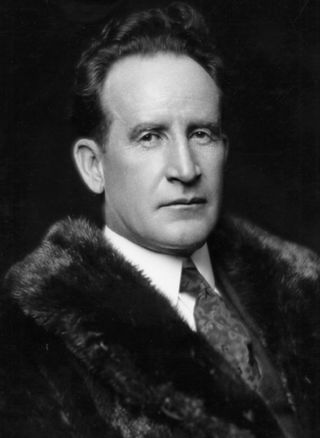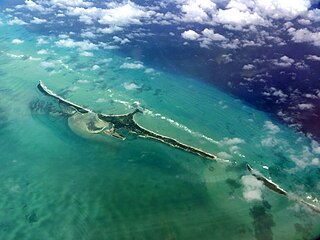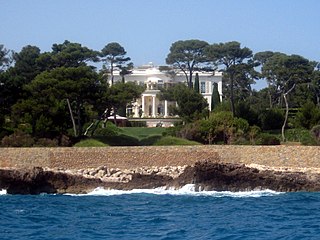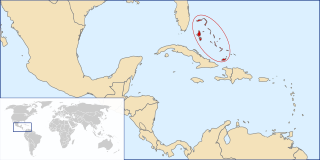
The Bahamas, officially the Commonwealth of The Bahamas, is an island country within the Lucayan Archipelago of the West Indies in the Atlantic Ocean. It contains 97% of the Lucayan Archipelago's land area and 88% of its population. The archipelagic state consists of more than 3,000 islands, cays, and islets in the Atlantic Ocean, and is located north of Cuba and northwest of the island of Hispaniola and the Turks and Caicos Islands, southeast of the U.S. state of Florida, and east of the Florida Keys. The capital is Nassau on the island of New Providence. The Royal Bahamas Defence Force describes The Bahamas' territory as encompassing 470,000 km2 (180,000 sq mi) of ocean space.

The earliest arrival of people in the islands now known as The Bahamas was in the first millennium AD. The first inhabitants of the islands were the Lucayans, an Arawakan language-speaking Taino people, who arrived between about 500 and 800 AD from other islands of the Caribbean.

Duke of Windsor was a title in the Peerage of the United Kingdom. It was created on 8 March 1937 for the former monarch Edward VIII, following his abdication on 11 December 1936. The dukedom takes its name from the town where Windsor Castle, a residence of English monarchs since the time of Henry I, following the Norman Conquest, is situated. Windsor has been the house name of the royal family since 1917.

The Élysée Palace is the official residence of the President of the French Republic. Completed in 1722, it was built for nobleman and army officer Louis Henri de La Tour d'Auvergne, who had been appointed Governor of Île-de-France in 1719. It is located on the Rue du Faubourg Saint-Honoré near the Champs-Élysées in the 8th arrondissement of Paris, the name Élysée deriving from the Elysian Fields, the place of the blessed dead in Greek mythology. Important foreign visitors are hosted at the nearby Hôtel de Marigny, a palatial residence.

Kensington Palace is a royal residence set in Kensington Gardens, in the Royal Borough of Kensington and Chelsea in London, England. It has been a residence of the British royal family since the 17th century, and is currently the official London residence of the Prince and Princess of Wales, the Duke and Duchess of Gloucester, the Duke and Duchess of Kent, Prince and Princess Michael of Kent and Princess Eugenie and her husband Jack Brooksbank and their two sons.

The governor-general of The Bahamas is the representative of the Bahamian monarch, currently King Charles III, in the Commonwealth of The Bahamas. The governor-general is appointed by the monarch on the recommendation of the prime minister of The Bahamas. The functions of the governor-general include appointing ministers, judges, and ambassadors; giving royal assent to legislation passed by parliament; issuing writs for election.

Bagshot Park is a royal residence located near Bagshot, a village 11 miles (18 km) south of Windsor. It is on Bagshot Heath, a 50-square-mile (130 km2) tract of formerly open land in Surrey and Berkshire. Bagshot Park occupies 51 acres (21 ha) within the designated area of Windsor Great Park.

Sir Harry Oakes, 1st Baronet was a British gold mine owner, entrepreneur, investor and philanthropist. He earned his fortune in Canada and moved to the Bahamas in the 1930s for tax purposes. Though American by birth, he became a British citizen and was granted the hereditary title of baronet in 1939.

Anmer Hall is a Georgian country house in the village of Anmer in Norfolk, England. Built in the 19th century, it was acquired by the Sandringham Estate sometime after Queen Victoria purchased the property, and has previously been leased to business owners, civil servants, and members of the British royal family. It is currently the country residence of the Prince and Princess of Wales, given to the couple as a wedding gift by Elizabeth II.

The Grand Ducal Palace is a palace in Luxembourg City, in southern Luxembourg. It is the official residence of the grand duke of Luxembourg, and where he performs most of his duties as head of state of the Grand Duchy, though his principal residence is Berg Castle, in Colmar-Berg.
Sir Alfred Étienne Jérôme Dupuch, OBE, KSG was a Bahamian journalist and politician.

The Cat Cays are two islands in the Bahamas, North Cat Cay and South Cat Cay, approximately 10 miles (16 km) south of Bimini. North Cat Cay is a privately owned island and is run as a private members club by the Cat Cay Yacht Club. South Cat Cay is currently under development.

The following outline is provided as an overview of and topical guide to The Bahamas:

The monarchy of the Bahamas is a system of government in which a hereditary monarch is the sovereign and head of state of the Commonwealth of the Bahamas. The current Bahamian monarch and head of state since 8 September 2022, is King Charles III. As sovereign, he is the personal embodiment of the Bahamian Crown. Although the person of the sovereign is equally shared with 14 other independent countries within the Commonwealth of Nations, each country's monarchy is separate and legally distinct. As a result, the current monarch is officially titled King of the Bahamas and, in this capacity, he and other members of the royal family undertake public and private functions domestically and abroad as representatives of the Bahamian state. However, the King is the only member of the Royal Family with any constitutional role.

The Château de la Croë is a large detached villa situated in eight hectares of grounds on the Cap d'Antibes peninsula of the French Riviera, in the Alpes-Maritimes department of Southern France. The classical-style château was designed by architect Armand-Albert Rateau and built in 1927 for Sir Pomeroy Burton, general manager of Associated Newspapers.

Edward VIII, later known as the Duke of Windsor, was King of the United Kingdom and the Dominions of the British Empire, and Emperor of India, from 20 January 1936 until his abdication in December of the same year.

The following is an alphabetical list of topics related to the Commonwealth of The Bahamas.
4 route du Champ d'Entraînement, also known as Villa Windsor, is a historic villa in the 16th arrondissement of Paris, within the northwest section of the Bois de Boulogne, close to the southern edge of Neuilly-sur-Seine. The house from 1929 is owned by the City of Paris and leased to the family of Mohamed Al-Fayed. From 1952 until 1986, it was the Paris home of the Duke and Duchess of Windsor.

Adelaide Cottage is a house in Windsor Home Park just east of Windsor Castle, in Berkshire. Built in 1831 for Queen Adelaide, it is currently the principal residence of the Prince and Princess of Wales.
Sydney Johnson was a Bahamian-born personal attendant who notably served as the valet and footman to Prince Edward, Duke of Windsor, formerly King Edward VIII of the United Kingdom, and his wife, Wallis, Duchess of Windsor, for over thirty years. He later worked for the Egyptian businessman Mohamed Al-Fayed.



















